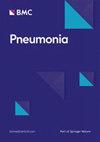Standardisation and evaluation of a quantitative multiplex real-time PCR assay for the rapid identification of Streptococcus pneumoniae
IF 8.5
Q1 RESPIRATORY SYSTEM
引用次数: 7
Abstract
Rapid diagnosis of Streptococcus pneumoniae can play a significant role in decreasing morbidity and mortality of infection. The accurate diagnosis of pneumococcal disease is hampered by the difficulties in growing the isolates from clinical specimens and also by misidentification. Molecular methods have gained popularity as they offer improvement in the detection of causative pathogens with speed and ease. The present study aims at validating and standardising the use of 4 oligonucleotide primer-probe sets (pneumolysin [ply], autolysin [lytA], pneumococcal surface adhesion A [psaA] and Spn9802 [DNA fragment]) in a single-reaction mixture for the detection and discrimination of S. pneumoniae. Here, we validate a quantitative multiplex real-time PCR (qmPCR) assay with a panel consisting of 43 S. pneumoniae and 29 non-pneumococcal isolates, 20 culture positive, 26 culture negative and 30 spiked serum samples. A standard curve was obtained using S. pneumoniae ATCC 49619 strain and glyceraldehyde 3-phosphate dehydrogenase (GAPDH) gene was used as an endogenous internal control. The experiment showed high sensitivity with lower limit of detection equivalent to 4 genome copies/µl. The efficiency of the reaction was 100% for ply, lytA, Spn9802 and 97% for psaA. The test showed sensitivity and specificity of 100% with culture isolates and serum specimens. This study demonstrates that qmPCR analysis of sera using 4 oligonucleotide primers appears to be an appropriate method for the genotypic identification of S. pneumoniae infection.快速鉴定肺炎链球菌的多重实时荧光定量PCR方法的标准化和评价
肺炎链球菌的快速诊断对降低感染的发病率和死亡率具有重要作用。肺炎球菌疾病的准确诊断受到临床标本中分离株生长困难和误诊的阻碍。分子方法已经获得了普及,因为它们提供了快速和容易的致病病原体的检测改进。本研究旨在验证和标准化在单反应混合物中使用4个寡核苷酸引物探针组(肺炎溶素[ply]、自溶素[lytA]、肺炎球菌表面粘附A [psaA]和Spn9802 [DNA片段])检测和鉴别肺炎链球菌。在这里,我们验证了一种定量多重实时PCR (qmPCR)检测方法,该方法由43个肺炎链球菌和29个非肺炎球菌分离物、20个培养阳性、26个培养阴性和30个加标血清样本组成。以肺炎链球菌ATCC 49619菌株为标准菌株,以甘油醛3-磷酸脱氢酶(GAPDH)基因为内源性内对照,获得标准曲线。实验结果显示灵敏度高,检测下限相当于4个基因组拷贝/µl。该反应对ply、lytA、Spn9802的反应效率为100%,对psaA的反应效率为97%。该方法对培养分离物和血清标本的敏感性和特异性均为100%。本研究表明,使用4个寡核苷酸引物对血清进行qmPCR分析是一种适合肺炎链球菌感染基因型鉴定的方法。
本文章由计算机程序翻译,如有差异,请以英文原文为准。
求助全文
约1分钟内获得全文
求助全文

 求助内容:
求助内容: 应助结果提醒方式:
应助结果提醒方式:


